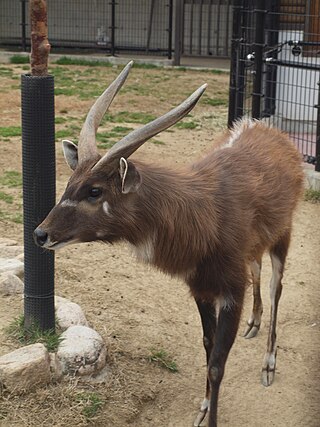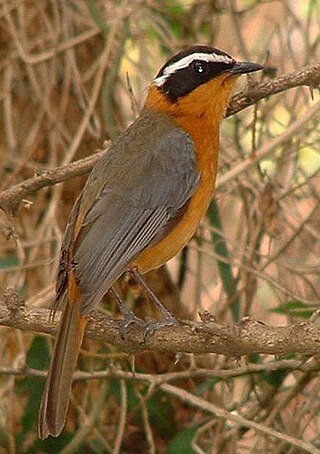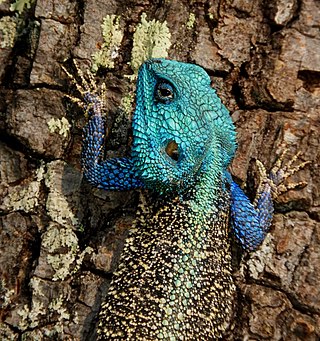
Laudakia is a genus of lizards, commonly known as Asian rock agamas, in the family Agamidae. The genus is found mostly in Asia, with some species in Southern Europe.

The Sinai agama is an agamid lizard found in arid areas of southeastern Libya, eastern Egypt, Israel, Jordan, Syria, Saudi Arabia, Oman, eastern Sudan, Ethiopia, Eritrea, and Djibouti.

The beautiful sunbird, formerly placed in the genus Nectarinia, is a sunbird. It is native to tropical Africa, its range extending from Senegal and Guinea in the west to Sudan, South Sudan, Ethiopia, Tanzania and Kenya in the east.

The sitatunga or marshbuck is a swamp-dwelling medium-sized antelope found throughout central Africa, centering on the Democratic Republic of the Congo, the Republic of the Congo, Cameroon, parts of Southern Sudan, Equatorial Guinea, Burundi, Ghana, Botswana, Rwanda, Zambia, Gabon, the Central African Republic, Tanzania, Uganda and Kenya. The sitatunga is mostly confined to swampy and marshy habitats. Here they occur in tall and dense vegetation as well as seasonal swamps, marshy clearings in forests, riparian thickets and mangrove swamps.

The lesser kudu is a medium-sized bushland antelope found in East Africa. The species is a part of the ungulate genus Tragelaphus, along with several other related species of striped, spiral-horned African bovids, including the related greater kudu, the bongo, bushbuck, common and giant elands, nyala and sitatunga. It was first scientifically described by English zoologist Edward Blyth (1869).

The greater kudu is a large woodland antelope, found throughout eastern and southern Africa. Despite occupying such widespread territory, they are sparsely populated in most areas due to declining habitat, deforestation, and poaching. The greater kudu is one of two species commonly known as kudu, the other being the lesser kudu, T. imberbis.

The sable antelope is a large antelope which inhabits wooded savanna in East and Southern Africa, from the south of Kenya to South Africa, with a separated population in Angola.

The red-billed quelea, also known as the red-billed weaver or red-billed dioch, is a small—approximately 12 cm (4.7 in) long and weighing 15–26 g (0.53–0.92 oz)—migratory, sparrow-like bird of the weaver family, Ploceidae, native to Sub-Saharan Africa.

The African sheath-tailed bat is a species of sac-winged bat in the family Emballonuridae.

The freckled nightjar or freckled rock nightjar is a species of nightjar in the family Caprimulgidae. It has a wide yet patchy distribution throughout the Afrotropics.

The black-bellied bustard, also known as the black-bellied korhaan, is an African ground-dwelling bird in the bustard family.

The white-browed robin-chat, also known as Heuglin's robin, is a species of bird in the family Muscicapidae. Found in east, central and southern Africa, its natural habitats include riverine forest and thickets, and it is also found near humans. The IUCN classifies it as a least-concern species.

The amethyst sunbird, also called the black sunbird, is a species of passerine bird in the family Nectariniidae. It is native to the Afrotropics, mostly south of the equator. They are commonly found in well-watered habitats, and undertake seasonal movements to visit flowering woodlands. The demise of some woodlands have impacted their numbers locally, but their range has also expanded along with the spread of wooded gardens.

The little spotted woodpecker or green-backed woodpecker, is a species of bird in the family Picidae. It is native to large parts of tropical central Africa. It has an extensive range and is an uncommon species, and the International Union for Conservation of Nature has rated its conservation status as being of "least concern".

The bearded woodpecker is a species of bird in the family Picidae. It has a distinctive black and white head and brownish barred body. It is native to tropical central Africa. It has an extremely wide range and is a fairly common species, and the International Union for Conservation of Nature has rated its conservation status as being of "least concern". Some taxonomic authorities place this species in Dendropicos.

Platysaurus broadleyi, also known commonly as the Augrabies flat lizard and Broadley's flat lizard, is a species of lizard in the family Cordylidae. The species is endemic to South Africa.

The common agama, red-headed rock agama or rainbow agama is a species of lizard from the family Agamidae found in most of sub-Saharan Africa. To clear up centuries of historical confusion based on Linnaeus and other authors, Wagner et al. designated a neotype for the species, using a previously described specimen from Cameroon in the collection of the Zoologisches Forschungsmuseum Alexander Koenig in Bonn. The species name was formerly applied to a paraphyletic collection of taxa ; subsequent mitochondrial DNA analysis of various populations indicates they represent separate species. Consequently, three former subspecies A. a. africana, A. a. boensis, and A. a. mucosoensis are now considered separate species, and A. a. savattieri is considered synonymous with A. africana.

Acanthocercus adramitanus, also known commonly as Anderson's rock agama or the Hadramaut agama, is a small species of lizard in the family Agamidae. The species is endemic to the Arabian Peninsula.

Acanthocercus cyanocephalus, also commonly known as Falk's blue-headed tree agama, is a species of lizards in the family Agamidae. It can be found in Angola, Namibia, Zambia, and the Democratic Republic of the Congo. With a maximum length of up to 350 millimeters, the tree agama is large in its genus; however, its tail is small when compared with its size. Male lizards, with their blue heads, spotted bodies, and multipatterned tails, are clearly distinct from all other species. Blue-headed tree agamas are known to eat arthropods including spiders, caterpillars, ants, and termites.


























